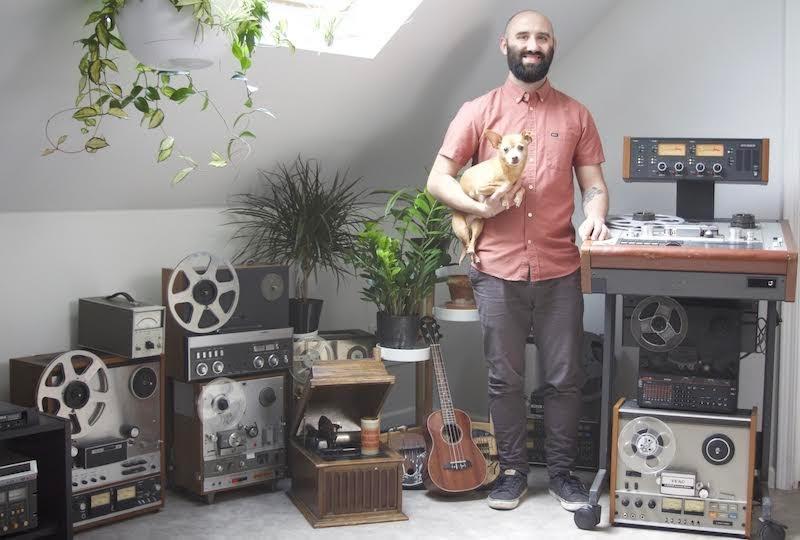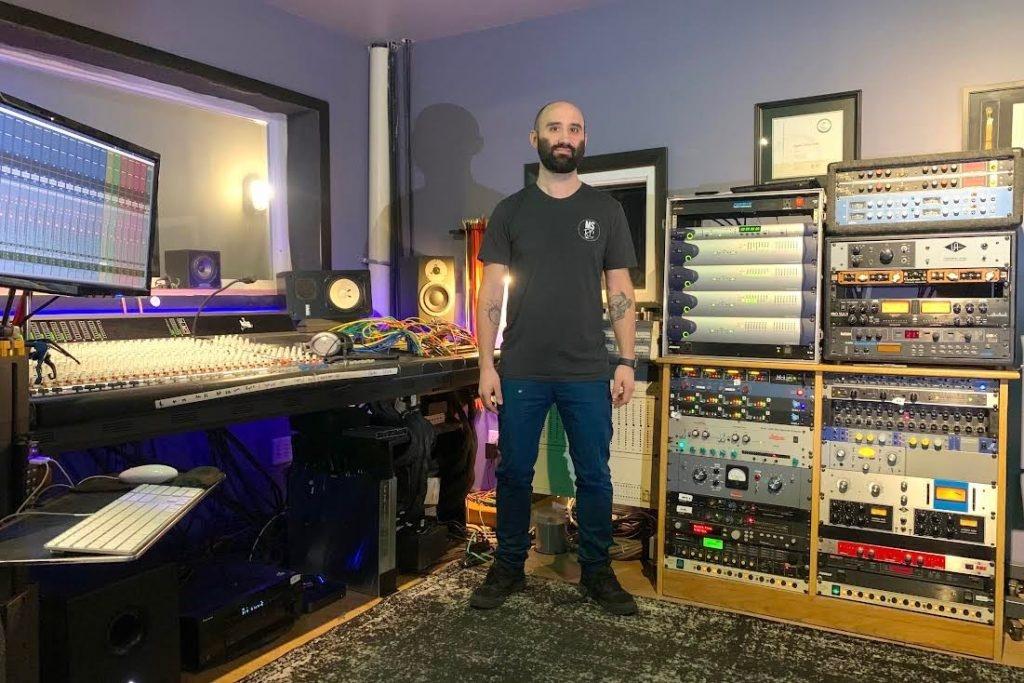A Q&A with Mystery Street Recording Company Owner/Audio Engineer Joe Tessone

Original Interview at American Blues Scene by Brant Buckley

Joe Tessone is the owner and lead audio engineer at Mystery Street Recording Company. He is a graduate of Columbia Colleges Chicago’s Audio Design and Production program, as well as an adjunct professor at the college in the Audio Arts and Acoustics department. Since 2007, he has specialized in Audio Preservation and legacy format digitization, working with audio archives of Old Town School of Folk Music, the Johnny Cash estate, Museum of Contemporary Art Chicago, and beyond. In addition to working in the studio with countless local Chicago bands, he has mastered songs by world-renowned artists including Pete Seeger, Jeff Tweedy, Mahalia Jackson, Donovan, Andrew Bird, and more.
In the world of live sound, he is a consultant for Sensaphonics Hearing Wellness, offering advice and training for safe in-ear monitor use to other engineers, doctors of audiology, and artists such as The Decemberists, My Morning Jacket, Wayne Kramer, and David Crosby. He is also the head of audio Sofar Sounds Chicago, providing live recording and live sound support for hundreds of performances each year.
Do you have any favorite blues recordings?
One Blues artist who had a particularly big impact on me was Lead Belly. The Smithsonian Folkways album Where Did You Sleep Last Night just blew my mind. Specifically, the way that a rock band like Nirvana could borrow a wildly powerful song like that and open a whole generation to a voice of the past really opened my eyes to how music can transcend a time and place.
As cliche as it is, being an 8-year-old kid in suburbia, how else would I have heard a song like that if it wasn’t for that moment on Unplugged? When I was old enough to start discovering my own music, I looked into the history of that song and of this Lead Belly fellow that Cobain was talking about, and I found the Folkways recordings. As I moved into my audio career, it shaped my priorities and truly inspired me to master the craft of audio preservation.
How did you get into recording?
My first introduction to recording was making goofy little 60-second audio montages on a Windows 95 computer’s “Sound Recorder.” That interest matured once I started playing in a punk band in junior high and we started making demos on a 4-track cassette recorder. In my later teens, I started using my PA system to run shows and built up my rig with a Pro Tools system and began doing live recordings for bands. It wasn’t until then that I realized that I might actually have a talent in this and I enrolled in Columbia College Chicago to hone in the craft.
Can you talk about Mystery Street Recording?
Mystery Street Recording started in 2007, a month after I graduated from Columbia. We opened first and foremost as a recording studio, but quickly began expanding into other areas of audio production, such as band rehearsal spaces, live sound, and, of course, audio preservation. We are now the highest rated recording company in Chicago, and the only one that runs completely on solar energy.
As a company, we always aim to push the limits of what can be done with audio and how we can engage with people beyond a generally insular industry. We have supported dozens of local non-profit groups over the years through fundraisers and gear support, and we are just typically known for being welcoming and easy going, while still being able maintain some of the highest standards in the business.
Can you talk about the audio restoration process?
Audio restoration is generally a phase of production that takes place after we have created a high-resolution preservation digitization of a legacy format, although sometimes it is simply fixing up a bad sounding recording. Generally, restoration will be followed up by mastering. The goal of audio restoration is to remove the imperfections in a recording caused by poor techniques, low quality gear, damaged media, or quite often, an inexperienced audio engineer.
There is an art to it that can take years to master and you have to be aware of the countless problems that could be happening with a recording, as well as how to correct them. The tools available for restoration are still very limited, but have gotten much better over the last decade. When I first started restoration work, if I wanted to remove the sound of ground hum from a recording, my only choice was to get rather surgical with EQ or Phase Inverting, but now there is software available, which if you know how to use properly, can remove just about any unwanted noise from a bad recording.
The dangerous thing with it, though, is if you don’t know how to use it properly, you can easily make something sound worse than the original. It is all about finding a balance.
Sounds like you work a lot with large archives and museums. How did this come about?
I got my start in audio archiving and preservation working as an intern at the Old Town School of Folk Music. The archive’s audio preservation initiative there was new and was doing some very innovative things, especially for 2007. It had a buzz around town and other organizations wanted to know who was helping them access these old recordings, and that happened to be me. I had a staff position as an audio archivist at the OTS for a few years, but as Mystery Street took off, I transitioned over to becoming a vendor for Old Town School’s audio preservation work, as well as the countless other archives, radio stations, and museums who come to me for archival quality preservation jobs of all sorts.
What have been some of your favorite projects that you have worked on?
One of the largest production projects that I’ve done was 127 Songs Live From The Old Town School. It was a collection of live recordings that I had transferred from their original formats to digital, and then went on to master. There were so many great artists on this project, including Big Bill Bronzy, Pete Seeger, Mahalia Jackson, Steve Earle, Andrew Bird, and Jeff Tweedy. Some samples of that project, plus other parts of that archiving project can be heard here.
More recently, I had the honor of working on a one-of-a-kind tape of an unreleased Johnny Cash performance, and also a re-release of an Ella Jenkins holiday album.
What is the hardest part about being a sound engineer?
The hardest part is finding a realistic work/life balance. Luckily, my wife Kristen works with me in Mystery Street’s Audio Preservation Lab, so we are together a lot. But we also have kids and operate a non-profit animal rescue, sanctuary, and habitat restoration organization called Mystery Meadows. It means late nights, early mornings, and odd hours all around.
You also teach at Columbia College in Chicago?
Yes! I was invited to teach at my alma mater a few years ago. My primary focus is a class called Principles of Audio Preservation, Mastering, and Deliverables. It is a fantastic course that I wish was around when I was a student there! I’m proud to have gone full circle, taking an audio preservation internship through the school in my final semester as a student, to teaching the subject now 15 years later.
Where do you see recording, audio, and sound going in the future?
Since the beginning, there has always been a trend towards DIY home recording and it was at a major peak when we first opened Mystery Street. Since then, I noticed home recording losing its appeal and a big trend back to higher quality recording in a professional setting, but then pandemic hit and the entire music industry took a 180. I’m not totally convinced that as an industry that we will ever go back to business as usual, but that just means that we have to pivot a bit.
My company has made huge expansions into intimate live recordings, remote or unattended mixing and mastering sessions, and live streaming. Things are different than they were, and for me, it is honestly ok. I really like to see our industry make technological progress, because it makes the job fun. There is always something more to learn and explore. So ultimately, I see the industry going in a direction of better, more user-friendly technology, but also, I see a major need to be a guardian of the old technology since countless recordings have been done using them. I’m happy to be a part of that process and contribute to both modern music production and the revitalization of classic recordings at the same time.
What’s next for you?
In audio, I am continuing to expand the company’s audio preservation services and also putting a strong focus on audio/visual content creation. Outside of the studio, Kristen and I will be working hard this summer to grow Mystery Meadows now that we have received our 501(c)3 status. We have plans to expand our farm sanctuary and be able to provide a home to more animals and additional species, as well as furthering our cultivation of native plants and permaculture gardening.

